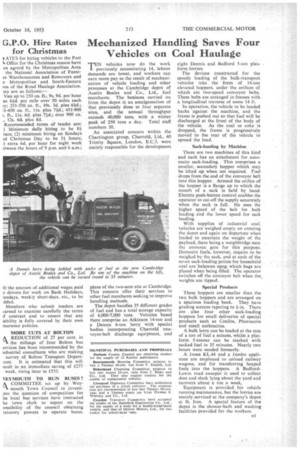Mechanized Handling Saves Four Vehicles on Coal Haulage
Page 37

If you've noticed an error in this article please click here to report it so we can fix it.
-r-EN vehicles now do the work I previously necessitating 14, labour demands are lower, and workers can earn more pay as the result of mechanization of vehicle loading and other processes at the Cambridge depot of Austin Beaks and Co., Ltd., fuel merchants. The business carried on from the depot is an amalgamation of that previously done at four separate sites, and the annual throughput exceeds 40,000 tons, with a winter peak of 250 tons a day. Total staff numbers 30.
An associated concern within the Charrington group, Charrold, Ltd., 40 Trinity Square, London, E.C.3, were mainly responsible for the development plans of the two-acre site at Cambridge. This concern offer their services to other fuel merchants seeking to improve handling methods.
The depot handles 35 different grades of fuel and has a total storage capacity of 6,000-7,000 tons. Vehicles based there comprise an Atkinson 14-ton and a Dennis 6-ton lorry with special bodies incorporating Charrold conveyor-belt discharge equipment, and eight Dennis and Bedford 5-ton platform lorries.
The devices constructed for the speedy loading of the bulk-transport vehicles take the form of 14-ton elevated hoppers, under the orifices of which are two-speed conveyor belts, These belts are arranged in frames with a longitudinal traverse of some 14 ft.
In operation, the vehicle to be loaded backs against the machine, and the frame is pushed out so that fuel will be discharged at the front of the body of the vehicle. As the coal or coke is dropped, the frame is progressively moved to the rear of the vehicle to spread the load.
Sack-loading by Machine There are two machines of this kind and 'each has an attachment for automatic sack-loading. This comprises a smaller, secondary hopper which may be lifted up when not required. Fuel drops from the end of the conveyor belt into this hopper. Around the orifice of the hopper is a flange up to which the mouth of a sack is held by hand. Electric push-button control enables the operator to cut-off the supply accurately when the sack is full. He uses the higher speed of the belt for bulk loading and the lower speed for sack loading.
With supplies of industrial coal, vehicles are weighed empty on entering the depot and again on departure when loaded to ascertain the weight of the payload, there being a weighbridge near the entrance gate for this purpose. Domestic fuels, however, require to be weighed by the sack, and at each of the seven sack-loading points for househOld coal arc balances upoia which bags are placed when being filled. The operator switches off the conveyor belt when the weights are tipped.
Special Products These hoppers are smaller than the two bulk hoppers and are arranged on a spacious loading bank. They have grading screens tapering to 4-in. There are also four other sack-loading hoppers for small deliveries of special products such as Coalite, Phurnacite and small anthracites.
A bulk lorry can be loaded at the rate of a ton of fuel a minute, whilst a platform 5-tonner can be stacked with sacked fuel in 35 minutes. Nearly two hours were .needed formerly.
A Jones KL.44 and a Jumbo appliance are employed to unload railway wagons, and for transferring heaped fuels into the hoppers. A BedfordLewin road sweeper is used to collect dust and slack lying about the yard and recovers about a ton a week.
Equipment is provided for vehicle running maintenance, but the lorries are mainly serviced at the company's depot at St, Ives. A special feature of the depot is the shower-bath and washing facilities provided for the workers.




























































































